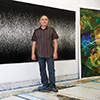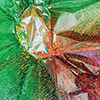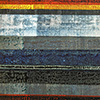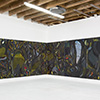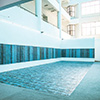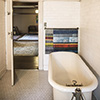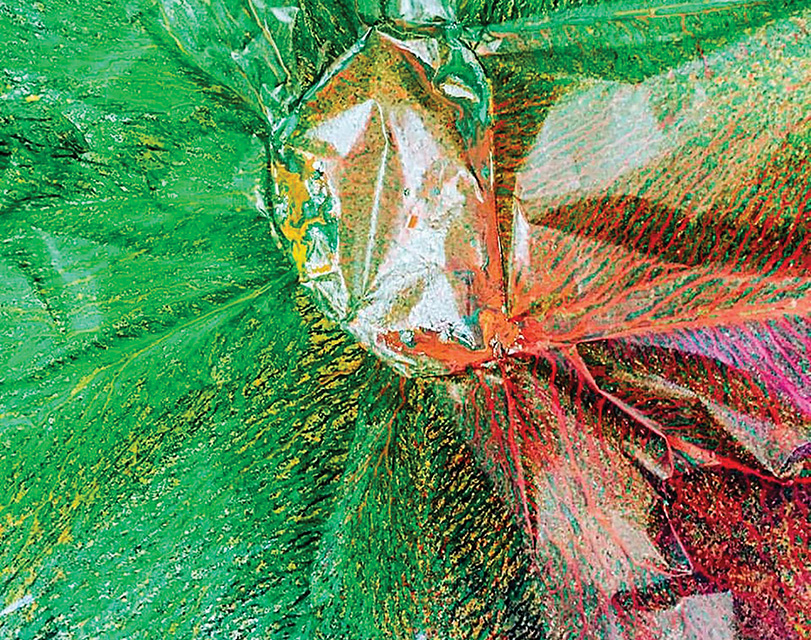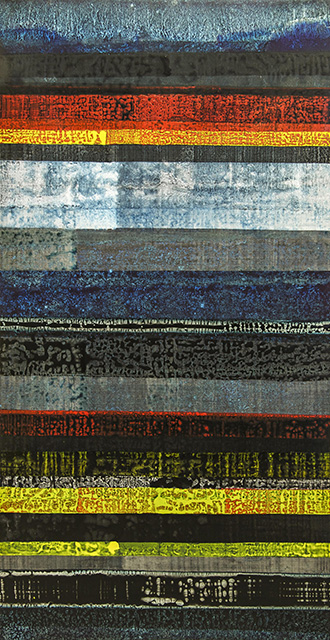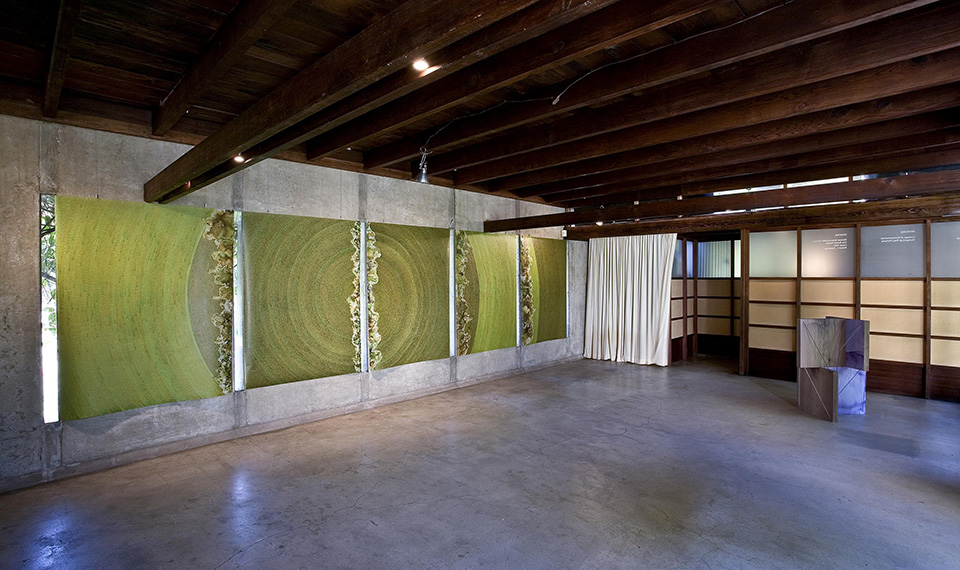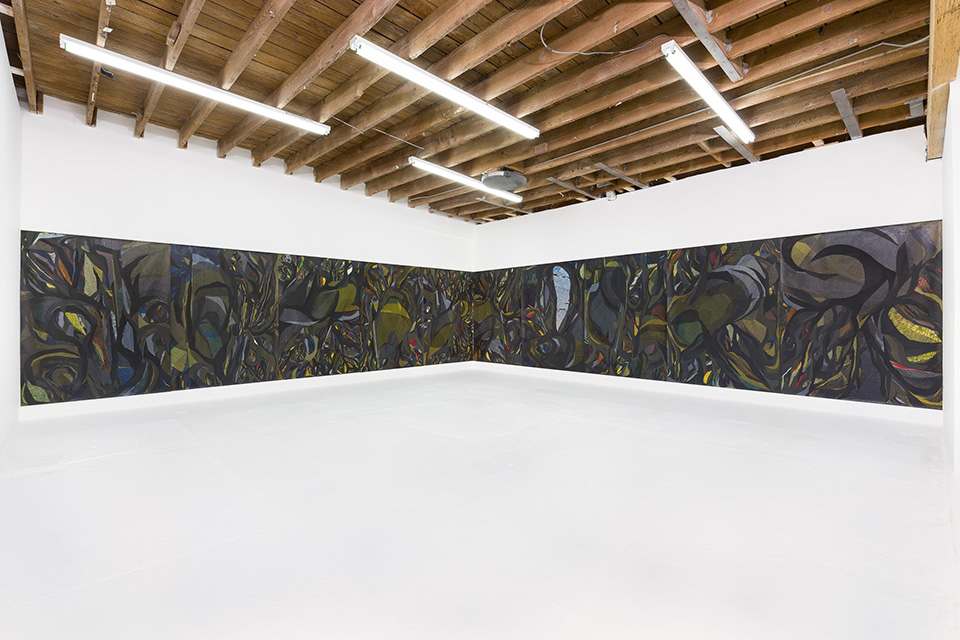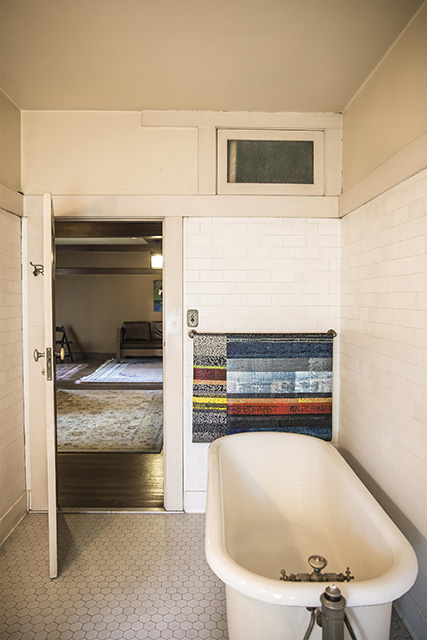Sandeep Mukherjee
SANDEEP MUKHERJEE: Performing Site
When considering the art of Sandeep Mukherjee, it is best to think not in nouns but in verbs. His large-scale, site-sensitive works are often composed in modular panels that can be reconfigured as the site of their exhibition shifts. He mystifies the eye in his refusal to insist on continuity from one panel to the next even as the viewer comprehends the logic of his pieces. The larger works often have the ability to exist partial or whole while never being incomplete.
Traditionally we think of the space housing the work, but in the case of Mukherjee's art the work communes with the space—turning corners, echoing shadows, absorbing light, and making room simply for what is there. Nothing preexists as a container. Over the past sixteen years he has not simply shown paintings in his exhibitions; he has created conversations with varying and distinct environments all over the world, from Bangladesh to the Schindler House in Los Angeles.
Mukherjee's The Sky Remains (2016) refers specifically to the sky occupying or populating space, which is exactly what he did with one thousand tiles and sixteen panels spanning seventy feet, installed as part of the Dhaka Art Summit. The blues of the piece turned the sky into both a reflector and a container of Bangladesh's many rivers. And though the piece cannot be said to be representational, it suggests by virtue of the silt-like orange and the openness of the spreading blues a natural rain. The sequence of wall panels is interchangeable and overlaps in order to expand or contract to the length of the space, much like folds of a pulsating accordion.
The tiles in The Sky Remains were individually carved and painted and installed as a full grid on the floor, where they were sequentially painted with horizontal and vertical stripes. The grid was reconfigured through the process so that multiple weavings occurred through time—a reference to the rich tradition of weaving in the geographic region of Bangladesh. The tiles also underline the importance of the haptic sensation in Mukherjee's work. Our ability to see through touch brings forward multiple senses in the space, where viewers were encouraged to walk barefoot on the textured floor/sky.
In 2015 Mukherjee exhibited Mutual Entanglements, composed of ten modular panels, each seven feet tall and five feet wide, at Los Angeles's Chimento Contemporary. The panels were conceived in relation to a standing human figure. The space was built around the exact dimensions of the piece so that the entire fifty feet would be folded at the center, forming two symmetrical twenty-five-foot segments. Though the title of the piece could easily refer to the colors—which seemed lifted from the natural world to depict a dense unnatural landscape created through the use of brooms, brushes, Q-tips, and cleaning products—the piece's placement in the gallery spoke to its inherent elasticity. No pattern was repeated or continued from panel to panel, and despite each panel's individuality within the piece, each existed with an inevitability that tied the work to the space in a closed universe. The work's ultimate cohesiveness created an air of suspension within the traditional white walls. Two panels were later shown as individual works, speaking to the work's adaptability.
Mukherjee has made site-sensitive a verb. Perhaps stemming from his training as an engineer, his artistic work has an organic adaptability that speaks to its environment. Depending on the time of day or night and the viewer's position, the work becomes a membrane that keeps changing, an interface between inside and outside. Luminosity, opacity, color, materiality, texture—all are shifting properties of the work that have an innate architectonic rhythm. Gravity Folds (2016), Mukherjee's new work on view in the C.O.L.A. exhibition, extends the idea of site-sensitivity into performance. The panels have been used to lift his body off the ground in various positions, resulting in sculptural forms that will be installed on the wall as continuous shedding skin. The piece relates to the cantilevered balcony adjacent to the C.O.L.A. galleries, which overlooks the city.
—Claudia Rankine
Sandeep Mukherjee
Born 1964, Pune, India
Lives and works in Los Angeles
Education
MFA, University of California, Los Angeles, 1999
BFA, Otis College of Art and Design, Los Angeles, 1996
MS, industrial engineering and operations research, University of California, Berkeley, 1988
BS, industrial engineering, Manipal Institute of Technology, India, 1986
Selected Exhibitions
2016 The Sky Remains (site-sensitive installation), Dhaka Art Summit 2016, Bangladesh (solo)
2015 Mutual Entanglements, Chimento Contemporary, Los Angeles (solo)
2014 A Machine Project Field Guide to the Gamble House, Pasadena, CA (group)
2012 Meticulosity, Ben Maltz Gallery, Otis College of Art and Design, Los Angeles (group)
2011 Selections from the Hammer Contemporary Collection, Hammer Museum, Los Angeles (group)
2008 Spell: Sandeep Mukherjee, Broad Center, Pitzer College, Claremont, CA
2004 Project 21: Sandeep Mukherjee, Pomona College Museum of Art, Claremont, CA
2003 International Paper: Drawings by Emerging Artists, UCLA Hammer Museum, Los Angeles (group)
Selected Bibliography
Isé, Claudine. "Sandeep Mukherjee." In International Paper: Drawings by Emerging Artists.
Los Angeles: UCLA Hammer Museum, 2003.
Kraus, Chris, Jan Tumlir, and Jane McFadden. LA Artland: Contemporary Art from Los Angeles.
London: Black Dog, 2005.
Rattemeyer, Christian. The Judith Rothschild Foundation Contemporary Drawings Collection:
Catalogue Raisonné. New York: Museum of Modern Art, 2009.
Artist's Website
www.sandeepmukherjeeart.com

